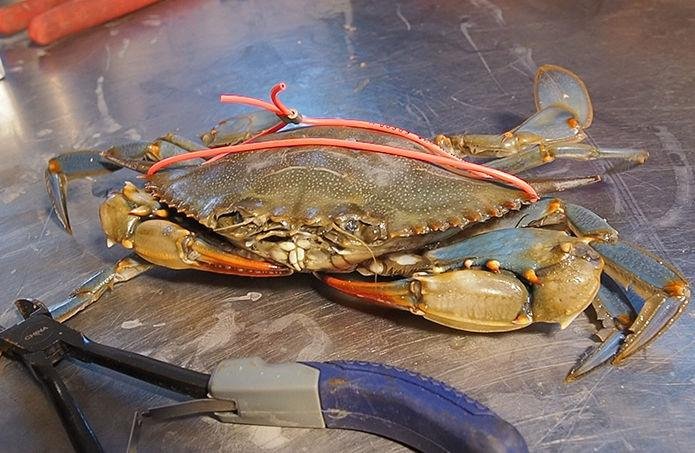
RICHMOND, Va. – Virginia’s fishery managers have lifted the longstanding ban on dredging for blue crabs during the winter in the Chesapeake Bay, a seismic policy shift that drew strong criticism from their Maryland counterparts and conservationists.
The Virginia Marine Resources Commission voted 5–4 on June 25 to repeal the 16-year prohibition on winter dredging. The board is expected to reconvene in September to consider staff recommendations on how to implement the fishery. The new season could open as early as this December.
“It’s a stopgap to keep our industry moving and keep our waterman working during those winter months,” said Zach Widgeon, a VMRC spokesman. But, he added, “this is not us turning loose a fleet of boats to go out winter crab dredging right now. [Repealing the prohibition] opens up that dialog for our staff to go ahead and find these answers out.”
The board’s action came after the VMRC’s Crab Management Advisory Committee, which is mostly made up of industry members, voted 10–2 in favor of reopening the winter season. After that May 29 vote, the agency received 186 public comments on the proposal — all in opposition.
In addition, the VMRC’s own staff had urged the board against doing so, pointing to a declining trend in overall crab numbers in recent years.
“The reason staff recommend not opening at this time is [that] the abundance is still below average,” said Pat Geer, VMRC’s chief of fisheries management. He added that allowing watermen to harvest crabs in the winter would upend an ongoing species stock assessment, which is set for completion in 2026.
Conservation groups say they strongly oppose the reopening, arguing it would make it harder to maintain the species at a healthy population.
“It is incredibly disappointing,” said Chris Moore, the Chesapeake Bay Foundation’s Virginia director. “The VMRC’s vote imperils not only the vulnerable blue crab, but the sustainability of harvests throughout the year and other species in the Bay that depend on the blue crab for food.”
The move would also put Virginia at odds with neighboring Maryland, where winter dredging has long been banned. Crabs move freely between both states’ portions of the Bay during different parts of their life cycles.
Maryland fishery managers quickly denounced the VMRC’s action.
“The success of the species’ recovery after a steep decline in the 2000s can be directly traced to Maryland and Virginia cooperatively managing blue crabs, especially females, based on science,” said Maryland Department of Natural Resources Secretary Josh Kurtz. “Today’s action by Virginia breaks with this successful approach.”
Dredging involves dragging a metal, rake-like apparatus behind a boat to scoop up semi-dormant crabs from the mud. Female crabs migrate to the southern end of the Bay in the winter to release their eggs. As a result, they account for about 90% of the crabs caught in the winter in Virginia, Geer said.
A dramatic decline in the population led to a federal disaster declaration in 2008. Virginia, Maryland and the Potomac River Fisheries Commission responded by working together for the first time to enact shared harvest limits.
All three jurisdictions pledged to reduce the female harvest by 34%. In Virginia, the closure of the winter dredging fishery beginning in the 2008–2009 season was the centerpiece of the effort to protect crabs in that state’s portion of the Bay. From then forward, the VMRC board had reauthorized the prohibition every year until June’s vote.
All but one of the five votes supporting the repeal were made by members appointed by Republican Gov. Glenn Youngkin. Those were A.J. Erskine, Jamie Green, Spencer Headley and Lynn Kellum. They were joined by James Minor, who was appointed by Youngkin’s predecessor, Democratic Gov. Ralph Northam.
“I was here when we took it away from them,” Kellum said. “I’ve said this before: Are we being fair to that user group that we took it away from?”
In opposition were three Youngkin appointees — Will Bransom, Patrick Hand and Jeanette Edwards — and one Northam appointee, Heather Lusk.
To maintain the 34% reduction for the female harvest, critics warn that the VMRC will almost certainly have to offset the additional catch in the winter with cuts to the crab pot fishery, which accounts for 97% of the state’s current take.
“Opening this fishery in the winter would be for the benefit to the very few and come at a high risk to all crabbers,” Bransom said.
In 2008, when winter dredging was last permitted, the state issued 98 licenses, leading to a harvest of about 1.4 million pounds of crabs. That represented about 7% of the total annual harvest, according to VMRC records.
The VMRC estimates that about 15–20 crabbers would participate in the reopened fishery. The longtime prohibition closed the season from Dec. 1 to March 31. Headley suggested that crabbers should be allowed to dredge only in January and February.
In 2024, according to a recently released benchmark survey, the Baywide adult female crab population ticked down to 133 million from 152 million last year. But that figure is still above the recommended threshold of 72.5 million crabs.
The overall crab population in 2022 dipped to its lowest recorded level in the survey’s 32-year history, with an estimated 227 million crabs. That number jumped to 323 million in 2023 before falling once again in 2024 to 317 million.















